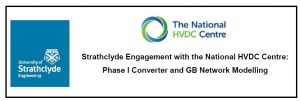
Project Background
To study the performance and dynamic response of a real system, vendor-specific models from manufacturers are required. However, such models are usually provided as “black-box” models with predefined inputs and outputs, and with no access to the internal converter structure and system control by the users. The restricted access to key internal converter and control system variables that describe system dynamics may hinder understanding of potential issues that may arise at converter and system levels from continued evolution of the power network. Therefore, to aid future network development, and identify potential problems and solutions with large renewable generation and HVDC connection, it is essential that accurate and high fidelity converter models are available for system studies.
Recent modular and hybrid multilevel voltage source converters for HVDC applications have adopted the concept of modular power electronics building blocks that employ thousands of semiconductor switching devices and capacitors, with each building block or submodule contains few switching devices and capacitors. Such an approach has enabled scalability of a single converter to significantly higher voltages and rated powers such as 640kV and 1000 MW. However, the exponential increase in the numbers of submodule makes their modelling and understanding of their dynamics increasingly challenging.
This project with the University of Strathclyde developed high-fidelity, open-access converter models across different Electro Magnetic Transient (EMT)-type simulation tools including PSCAD and RSCAD for real-time hardware-in-the-loop simulation studies.
Key Outputs [Please click links below to access technical reports]
- High-level Executive Summary of the Project: describing the key findings of the whole project and a summary of all technical reports, EMT-type models and publications.
- Report I: Development and Validation of Offline and Real-time User-defined Models of Alternative MMC Configurations
- Report II: Validation of Real-time User-defined MMC Models
- Report III: Offline DC grid model development
- Report IV: Development and Validation of Offline and Real-time User-defined Models of Alternative MMC Configurations
- Report V: DC Grid with User-defined Converter Models: Validation of Real-Time Model in RTDS against Offline Equivalents in PSCAD/EMTDC Environment
- Open-access Models: The offline (PSCAD) and real-time (RSCAD) models.
Publications
This paper presented at the IET AC-DC conference, 2018: “Detailed quantitative comparison of half-bridge modular multilevel converter modelling method”
Abstract—This paper presents a detailed comparison of different modelling methods of the half-bridge modular multilevel converter (HB-MMC), namely, switching function, Thevenin equivalent and averaged, considering both MMC implementations (large and reduced number of cells). The theoretical basis that underpins each modelling method are discussed. Offline PSCAD simulations are used to validate user-defined switching function and averaged MMC models against the Thevenin equivalent model provided in PSCAD library for accuracy, considering steady-state and dc fault conditions. Furthermore, the RTDS based real-time simulation results of the user-defined HB-MMC switching function model are validated against the above mentioned offline models, considering steady-state and dc short circuit fault operations. Simulation speed and efficiency of different offline HB-MMC models being studied in this paper are compared. From comprehensive corroboration of different HB-MMC models presented in this paper, it has been found that the averaged, switching function and Thevenin equivalent models produce practically identical results during steady-state and dc faults. In detailed offline and real-time simulation studies where fundamental and harmonic dynamics are of interest, switching function model is found to be faster and computational efficient compared to the Thevenin equivalent model.
To access this paper: https://strathprints.strath.ac.uk/63527/
This paper was presented at the IET AC-DC conference, 2019 : “Interoperability of different voltage source converter topologies in HVDC grids”
Abstract—This paper presents a detailed study of DC grid operation using a range of user-defined offline and real-time HVDC converter models which were rigorously validated against offline and real-time benchmarks. Provided that these models are destined for use in real-time hardware in the loop simulation and a wide range of offline system studies, this paper assesses their suitability for studying complex DC grids that consist of multiple voltage source converters which differ in their control range and fault ride-through capabilities. Detailed quantitative studies show that the offline and real-time DC grid models produce well-matched results and provide effective approaches to investigate DC grid operation during normal condition and AC and DC faults.
To access this paper: https://strathprints.strath.ac.uk/65998/
RTDS European User’s Group Meeting: “Realization of User-Defined HVDC Converter Models for RTDS using Simulink Real-Time Embedded Coder”, Oct. 2018
Abstract—In recent years, the uses of processor and hardware in the loops for testing and validation of control and protection systems prior installation in physical systems become increasingly popular and widespread within the industry and academia. However, the effectiveness and credibility of processor and hardware in the loops are highly dependent on the accuracy of the real-time models of the plants and controllers to be used.
As RTDS becomes a dominant real-time simulation platform being used within the industry to model and simulate HVDC systems, this presentation aims to show, how Simulink Real-Time Embedded Coder could be used to speed up the developing of efficient and high-fidelity user-defined components for RTDS platform such as HVDC converter models and control systems. To show the indisputable attributes of such approach in terms model development time and accuracy and ease of scalability, an illustrative example that implements a user-defined half-bridge MMC model will be presented, with its results will be validated against that of the offline and real-time half-bridge MMC in PSCAD and benchmark model ‘MMC5’ from RTDS library, with particular focus on the accuracy and simulation efficiency. Also, broader discussions of the attributes and potential limitations of such approach will be presented.
To download the RTDS User Group Meeting presentation please click here.

